Appearance#
Appearance is the parent-class of Background and Costume
Backgrounds and Costumes are also Appearances - All objects of these types inherit all attributes and methods who are defined in this class.
Appearance#
- class miniworlds.appearances.appearance.Appearance(*args, **kwargs)[Quellcode]#
Basisklasse von Actorkostümen und Welt-Hintergründen
Die Klasse enthält alle Methoden und Attribute, um Bilder der Objekte anzuzeigen und zu animieren, Text auf den Bildern darzustellen oder Overlays anzuzeigen.
Öffentliche Datenattribute:
Wenn wahr, wird das Bild über den Hintergrund gekachelt.
Wenn wahr, wird das Kostüm in Richtung des Tokens gedreht
Dreht das Kostüm oder den Hintergrund um.
Wenn True, wird das Bild unter Beibehaltung des Seitenverhältnisses hochskaliert.
Skaliert das Token auf die Größe des übergeordneten Elements, ohne das Seitenverhältnis beizubehalten.
Wenn True, wird das Bild vor der Drehung entsprechend der Ausrichtung des übergeordneten Elements gedreht.
Definiert eine farbige Schicht.
:py:obj:
Transparenz <miniworlds.appearances.appearance.Appearance.transparency>\Definiert eine Transparenz.
transparent, 255: sichtbar Wenn der Wert < 1 ist, wird er mit 255 multipliziert.
Wenn wahr, wird das Kostüm animiert.
->Füllfarbe anzeigen
Randfarbe sehen
Randfarbe des Akteurs
Die Randgröße des Akteurs.
Führt alle Aktionen in der Bildpipeline aus
In Unterklassen Kostüm und Hintergrund implementiert
image_managerÖffentliche Methoden:
__init__()set_image(source)Legt das angezeigte Bild des Kostüms/Hintergrunds auf den ausgewählten Index fest
set_mode(**kwargs)set_animated(value)flip(value)add_image(source)Fügt dem Erscheinungsbild ein Bild hinzu
add_images(sources)Fügt mehrere Bilder zum Hintergrund/Kostüm hinzu.
:py:obj:
animate <miniworlds.appearances.appearance.Appearance.animate>\ ([Schleife])Animiert das Kostüm
die Methode wird in den Unterklassen Kostüm und Aussehen überschrieben
Erstelle ein Array aus Kostüm oder Hintergrund.
from_array(arr)Erstellen Sie einen Hintergrund oder ein Kostüm aus einem Array.
fill(value)Standardfüllfarbe für Ränder und Linien festlegen
set_filled(value)get_color(position)get_rect()draw(source, position, width, height)draw_on_image(path, position, width, height)draw_color_on_image(color, position, width, ...)__str__()Gib str(self) zurück.
Wenn sie verschmutzt ist, wird das Bild neu geladen.
update()Lädt das nächste Bild, genannt 1/frame
:py:obj:
register <miniworlds.appearances.appearance.Appearance.register>\ (Methode)Methode für Dekorator registrieren.
:py:obj:
draw_shape_append <miniworlds.appearances.appearance.Appearance.draw_shape_append>\ (Form, Argumente)draw_shape_set(shape, arguments)draw_image_append(surface, rect):py:obj:
draw_image_set <miniworlds.appearances.appearance.Appearance.draw_image_set>\ (Oberfläche, Rechteck)set_dirty([value, status])In Unterklassen Kostüm und Hintergrund implementiert
Private Datenattribute:
_abc_implPrivate Methoden:
_set_defaults(**kwargs):py:obj:
_set_font <miniworlds.appearances.appearance.Appearance._set_font>\ (Schriftart, Schriftgröße)_set_animation_speed(value)_set_textured(value)bool: Wenn True, wird das Bild über den Hintergrund gekachelt.
_set_rotatable(value)Wenn auf Wahr gesetzt, wird das Kostüm mit der Actorrichtung gedreht
_set_centered(value)_set_flipped(value)Dreht das Kostüm oder den Hintergrund um.
_set_filled(value)Dreht das Kostüm oder den Hintergrund um.
_set_scaled(value)Setzt den Akteur auf die Eltern-Größe ohne das Seitenverhältnis beizubehalten.
_set_upscaled(value)Wenn auf Wahr gesetzt, wird das Bild unter Beibehaltung des Seitenverhältnisses hochskaliert.
_set_scaled_to_width(value)_set_scaled_to_height(value)_set_image(source)Legt das angezeigte Bild des Kostüms/Hintergrunds auf den ausgewählten Index fest
_before_transformation_pipeline()Aufgerufen in
get_image, wenn das Bild “dirty” ist (z. B. Größe, Drehung, ._after_transformation_pipeline()Aufgerufen in
get_image, wenn das Bild “dirty” ist (z. B. Größe, Drehung, ._load_image()Lädt das Bild,
_update_draw_shape()_inner_shape()Gibt die innere Form des Kostüms zurück
_outer_shape()Gibt die äußere Form des Kostüms zurück
_inner_shape_arguments()definiert setGets Argumente für innere Form
_outer_shape_arguments()Ruft Argumente für die äußere Form ab
- LOAD_NEW_IMAGE = 2#
- RELOAD_ACTUAL_IMAGE = 1#
- add_image(source)[Quellcode]#
Fügt dem Erscheinungsbild ein Bild hinzu
- Rückgabetyp:
- Rückgabe:
Index des erstellten Bildes.
- add_images(sources)[Quellcode]#
Fügt mehrere Bilder zum Hintergrund/Kostüm hinzu.
Jede Source im Source-Parameter muss ein gültiger Parameter für :py:attr:
Appearance.cimagesein
- after_animation()[Quellcode]#
die Methode wird in den Unterklassen Kostüm und Aussehen überschrieben
Beispiele
Der Akteur wird nach der Animation entfernt - Dies kann für Explosionen verwendet werden.
from miniworlds import * world = World() actor = Actor() costume = actor.add_costume("images/1.png") costume.add_image("images/2.png") costume.animate() @costume.register def after_animation(self): self.parent.remove() world.run()
- after_init()[Quellcode]#
- property alpha#
transparent, 255: sichtbar Wenn der Wert < 1 ist, wird er mit 255 multipliziert.
Beispiele
from miniworlds import * world = World(800,400) t = Actor((600,250)) t.add_costume("images/alien1.png") t.costume.alpha = 50 t.width = 40 t.border = 1 world.run()

- Typ:
definiert die Transparenz des Akteurs
- Typ:
0
- animate(loop=False)[Quellcode]#
Animiert das Kostüm
- Parameter:
loop – Wenn loop = True ist, wird die Animation als Schleife verarbeitet. (Sie können dies mit self.loop stoppen)
from miniworlds import * world = World(80,40) robo = Actor() robo.costume.add_images(["images/1.png"]) robo.costume.add_images(["images/2.png","images/3.png","images/4.png"]) robo.costume.animation_speed = 20 robo.costume.is_animated = True world.run()
- property animation_speed#
- property border#
Die Randgröße des Akteurs.
Der Wert ist 0, wenn der Akteur keinen Rand hat
- Rückgabe:
int
- Rückgabetyp:
_type_
- property border_color#
Randfarbe des Akteurs
- property color#
->Füllfarbe anzeigen
- property coloring#
Definiert eine farbige Schicht.
coloringkann True oder false sein. Die Farbe wird durch das Attributappearance.colordefiniert.
- counter = 0#
- property dirty#
- draw(source, position, width, height)[Quellcode]#
- draw_color_on_image(color, position, width, height)[Quellcode]#
- draw_image_append(surface, rect)[Quellcode]#
- draw_image_set(surface, rect)[Quellcode]#
- draw_on_image(path, position, width, height)[Quellcode]#
- draw_shape_append(shape, arguments)[Quellcode]#
- draw_shape_set(shape, arguments)[Quellcode]#
- fill(value)[Quellcode]#
Standardfüllfarbe für Ränder und Linien festlegen
- property fill_color#
- flip(value)[Quellcode]#
- property font_size#
- from_array(arr)[Quellcode]#
Erstellen Sie einen Hintergrund oder ein Kostüm aus einem Array. Das Array muss ein
numpy.ndarraysein, das mit.to_colors_arrayerstellt werden kannBeispiele
Konvertiere grauen Standardhintergrund in einen Farbverlauf
from miniworlds import * world = World() arr = world.background.to_colors_array() for x in range(len(arr)): for y in range(len(arr[0])): arr[x][y][0] = ((x +1 ) / world.width) * 255 arr[x][y][1] = ((y +1 ) /world.width) * 255 world.background.from_array(arr) world.run() world.background.from_array(arr) world.run()
Ausgabe:
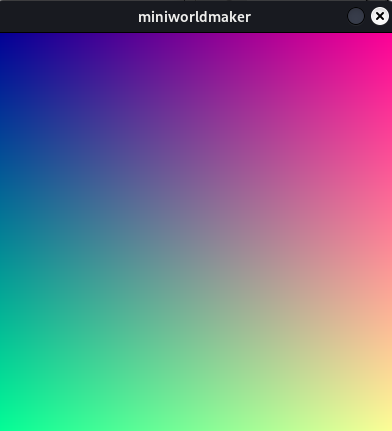
- get_color(position)[Quellcode]#
- get_image()[Quellcode]#
Wenn verschmutzt, wird das Bild neu geladen. Die Bildpipeline wird verarbeitet, definiert durch “set_dirty”
- abstract get_manager()[Quellcode]#
In Unterklassen Kostüm und Hintergrund implementiert
- get_modes()[Quellcode]#
- get_rect()[Quellcode]#
- property image: Surface#
Führt alle Aktionen in der Bildpipeline aus
- property images#
- property is_animated#
Wenn wahr, wird das Kostüm animiert.
from miniworlds import * world = World(80,40) robo = Actor() robo.costume.add_images(["images/1.png"]) robo.costume.add_images(["images/2.png","images/3.png","images/4.png"]) robo.costume.animation_speed = 20 robo.costume.is_animated = True world.run()
- property is_centered#
- property is_filled#
- property is_flipped#
Spiegelt das Kostüm oder den Hintergrund. Das Bild wird über die y-Achse des Kostüms/Hintergrunds gespiegelt.
Beispiele
Flippt Actor:
from miniworlds import * world = World() token = Token() token.add_costume("images/alien1.png") token.height= 400 token.width = 100 token.is_rotatable = False @token.register def act(self): if self.world.frame % 100 == 0: if self.costume.is_flipped: self.costume.is_flipped = False else: self.costume.is_flipped = True world.run()
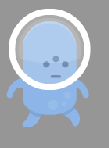

- property is_rotatable#
Wenn wahr, wird das Kostüm in Richtung des Tokens gedreht
- property is_scaled#
Skaliert das Token auf die Größe des übergeordneten Elements, ohne das Seitenverhältnis beizubehalten.
- property is_scaled_to_height#
- property is_scaled_to_width#
- property is_textured#
Wenn wahr, wird das Bild über den Hintergrund gekachelt.
Beispiele
Texturiere das Brett mit dem gegebenen Bild:
from miniworlds import * world = World() background = world.add_background("images/stone.png") background.is_textured = True world.run()
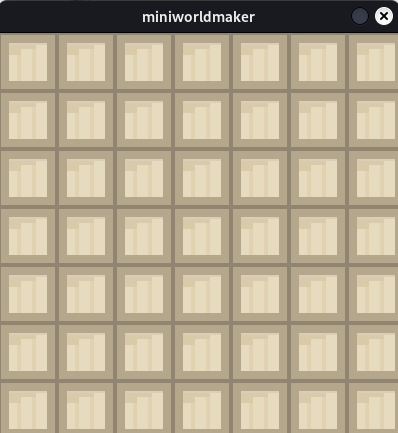
Texturgröße festlegen
from miniworlds import * world = World() background = world.add_background("images/stone.png") background.is_textured = True background.texture_size = (15,15) world.run()
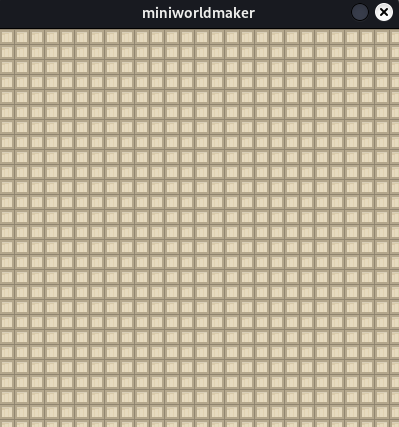
- Typ:
- property is_upscaled#
Wenn True, wird das Bild unter Beibehaltung des Seitenverhältnisses hochskaliert.
- property orientation#
Wenn True, wird das Bild vor der Drehung entsprechend der Ausrichtung des übergeordneten Elements gedreht.
Beispiele
Beide Actor steigen auf. Das Bild von t2 ist korrekt ausgerichtet. t1 schaut in die falsche Richtung.
from miniworlds import * world = TiledWorld() t1 = Actor((4,4)) t1.add_costume("images/player.png") t1.move() t2 = Actor((4,5)) t2.add_costume("images/player.png") t2.orientation = - 90 t2.move() @t1.register def act(self): self.move() @t2.register def act(self): self.move() world.run()
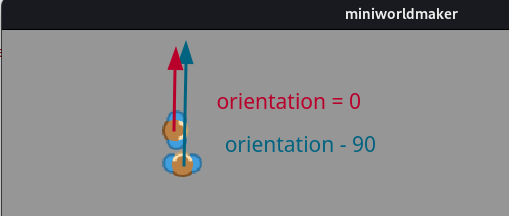
- Typ:
- register(method)[Quellcode]#
Registriere Methode für Dekorator. Registriert Methode für Akteur oder Hintergrund.
- remove_last_image()[Quellcode]#
- set_animated(value)[Quellcode]#
- set_dirty(value='all', status=1)[Quellcode]#
- set_filled(value)[Quellcode]#
- set_image(source)[Quellcode]#
Legt das angezeigte Bild des Kostüms/Hintergrunds auf den ausgewählten Index fest
- Rückgabetyp:
- Parameter:
source – Der Bildindex oder ein Bild.
- Rückgabe:
Wahr, wenn der Bildindex existiert
Beispiele
Fügen Sie zwei Bilder zum Hintergrund hinzu und wechseln Sie zu Bild 2
from miniworlds import * world = World() background = world.add_background("images/1.png") background.add_image("images/2.png") background.set_image(1) world.run()
- set_mode(**kwargs)[Quellcode]#
- property stroke_color#
Randfarbe sehen
- property texture_size#
- to_colors_array()[Quellcode]#
Erstelle ein Array aus Kostüm oder Hintergrund. Das Array kann mit
.from_arrayin ein Appearance umgeschrieben werdenExamples: :rtype:
ndarrayEin Hintergrundbild in Graustufen umwandeln
from miniworlds import * world = World(600,400) world.add_background("images/sunflower.jpg") arr = world.background.to_colors_array() def brightness(r, g, b): return (int(r) + int(g) + int(b)) / 3 for x in range(len(arr)): for y in range(len(arr[0])): arr[x][y] = brightness(arr[x][y][0], arr[x][y][1], arr[x][y][2]) world.background.from_array(arr) world.run()
Ausgabe:
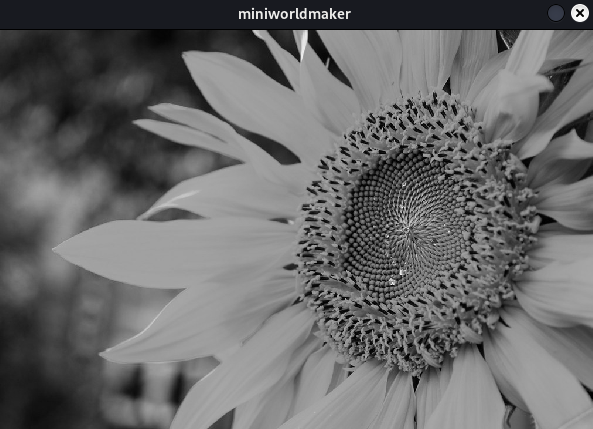
- property transparency#
Definiert eine Transparenz.
Wenn
transparencyTrueist, wird der Transparenzwert durch das Attributappearance.alphadefiniert
- update()[Quellcode]#
Lädt das nächste Bild, genannt 1/frame